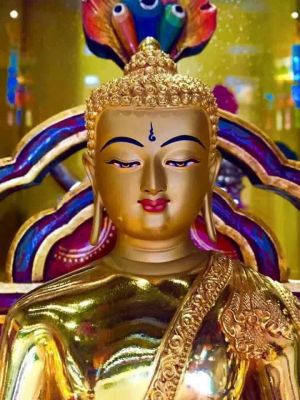50 Stanzas on Devotion to the Guru (Foreword)
Original text is from the Dharma Discourse Transcript by His Eminence, Garchen Rinpoche, one of the three great Rinpoches, the eighth reincarnation, at Zhi Gong Ga Er (Drikung Kagyu) Monastery.
Extracted from the website of Buddhist Vajrayana Charity Funds Association and translated (噶千寧波車對《事師法五十頌》之開示) into English:
A Chapter from the Dharma Discourse Transcript
In particular, a Vajrayana disciple once enters into tantric practice …, one must treat one’s Guru with the utmost respect even if the Guru does not possess all the merits and virtues primarily prescribed by the 《50 Stanzas on Devotion to the Guru》. In fact, a disciple is still able to gain the pure, unbroken lineage of
blessings from one’s Guru if one carries an attitude of devout sincerity, devotion and pure reverence towards one’s Guru. In this way the sacred samaya precept between Guru and disciple will also not be broken. If a disciple has doubts regarding one’s Guru’s intentions, even give rise to wrong views, it will plant a negative cause between Guru and disciple.
As the Guru has exceptional experiences in the practice of Buddha dharma and clearly understands every step of these experiences, the Guru is able to bestow upon our practice a superlative support. Only through the Guru, we are able to obtain initiations, continue to receive tantric teachings and secret verbal
transmissions. Merely being brilliant in possessing scripture is of no use at all! Let us elaborate further with an example! If a person wishes to go to Lhasa, it is better for him to be accompanied by an experienced tour guide as this guide will lead him safely to his destination. Furthermore, the tour guide
will be able to introduce scenic spots along the way and avoid any danger of missing ways. On the other hand, if a person wishes to go to Lhasa on his own, with only a map in hand, he will have no sense of direction or guidance. He may be able to calculate the distance to Lhasa or where to turn at junctions, but the actual journey will be very different.
Today’s Dharma discourse, the 《50 Stanzas on Devotion to the Guru》, is talking about how the Guru and disciple should treat each other and their relationship. In the past, both the Guru and disciples had to mutually examine each other’s behavior for twelve years. For example, the disciple would observe certain
aspects of the Guru as the criteria of not following the Guru, such as whether the Guru: lacked compassion, was selfish, got heavy anger, enjoyed taking part in activities that accumulate bad karma, was vindictive, was over-proud and pursued five-desire to satisfy his colorful lifestyle, etc. The practice conditions of
the past were far better than those at present. If we use the past criteria to observe the contemporary Guru, he may have some of the above mentioned faults that a disciple cannot rely upon him. Nevertheless, if one has chosen to follow one’s Guru and has obtained empowerments and numerous initiations, yet
subsequently sustains a negative perception of the Guru, this will reflect negatively on the Guru-disciple relationship. We should understand that even though the Guru may have some faults, the dharma doctrine which he teaches is not only of clear and pure lineage, but also possesses an immense blessing power. When
this is practiced together with reverent devotion and faith, we can still receive a tremendous blessing. Thus, should the Guru fall into disrepute, this will be the Guru’s own wrongdoing. Should the disciple subsequently develop the wrong perception, one too, will unfailingly follow in the Guru’s downfall.
Therefore, a disciple must not harbor any negative thoughts towards the Guru once one has received initiations and dharma transmissions. On the other hand, the disciple should also review and reflect one’s own behavior on a regular basis. Sometimes, it is due to our heavy karma that we consequently let
ourselves only see the Guru’s faults. This in turn prevents us from understanding the tantric doctrines and methods used by the Guru to our benefit. As a result, we totally misunderstand the Guru’s compassionate and benevolent heart.
Similarly, a disciple who is constantly harbor doubts, pride, wrong views will affect one’s body, speech and mind to do karma-behavior. One is also a demerit disciple.
The Guru has a complete tolerance and expresses it in three aspects.
Firstly, he withstands the acute sufferings inherent in the practice of Buddha dharma.
Secondly, he withstands all obstacles in the process of fulfilling his main obligation to help others.
Thirdly, he faces personal criticism from disciples to the extent of not giving way to anger.
The Guru’s heart is straightforward and non-cheating. The Guru does not deceive others by concealing his own mistakes, but must show his true nature when interacting with others. Furthermore, the Guru does not practise for personal gain or self-motive. The Guru whose outer nature appearance and inner soul are in complete accord, carries out Buddhist path to benefit others.
Source
[[1]]
